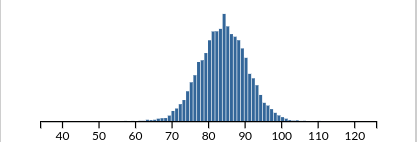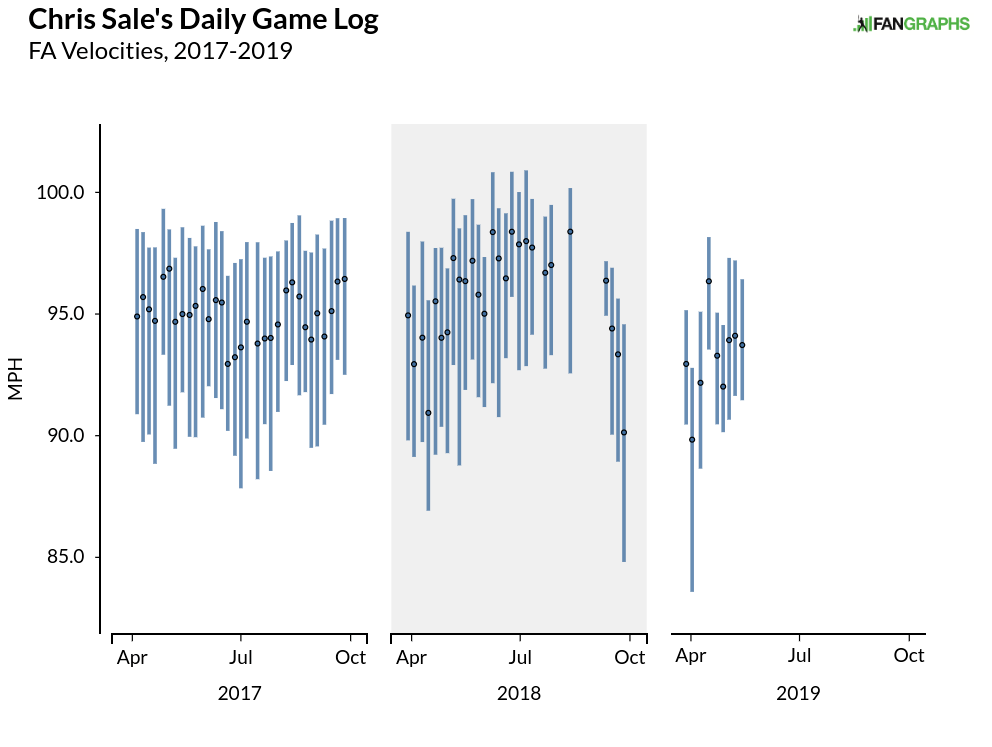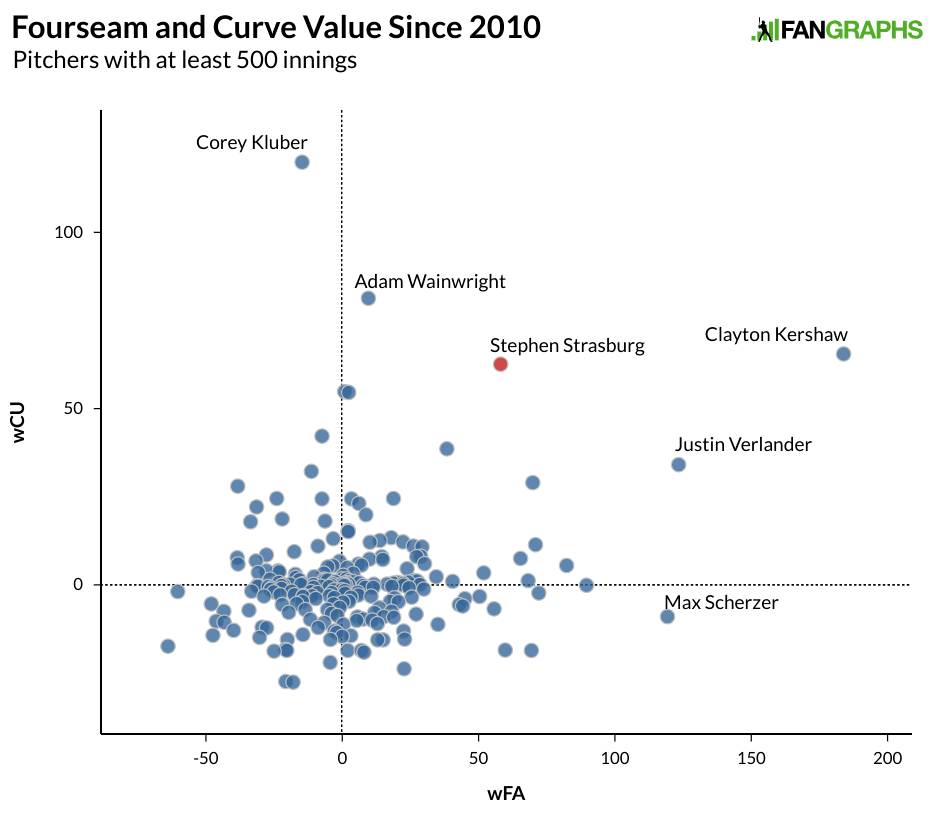Author Archive
Rafael Devers Is Still a Work In Progress
Generally speaking, doing more of one thing means doing less of another. A positive development can come at the expense of some other attribute and unintended consequences can make that positive thing decidedly less so. It’s one thing to strike out less often. Putting more balls in play provides the potential for positive outcomes. It’s another thing to strike out less often and walk more often. Doing those things in concert can have a great effect on getting on base and not making outs, which is almost always the point of every plate appearance from a hitter’s perspective. Sometimes, doing both doesn’t lead to positive results, and Rafael Devers found that out the first month of the season. Instead of going back, though, he’s moved forward and is hitting better than ever.
The 2018 season wasn’t a great one for Devers statistically. He wasn’t terrible, posting a slightly lower than average 8% walk rate and 24% strikeout rate, as well as better than average power with a .193 ISO, but a .281 BABIP meant a .240 batting average a sub-.300 on-base percentage and a below-average 90 wRC+. In his 2017 debut, Devers’ numbers were mostly the same, but a .342 BABIP meant a 110 wRC+. The Statcast data indicates that the difference between 2017 and 2018 was mostly luck, and Devers’ batted ball profile in terms of ground balls, line drives, and pulled balls were all pretty similar in 2017 and 2018, giving credence to Devers being a bit lucky in 2017, with 2018 his natural level if all else remained the same.
Devers wasn’t content with remaining the same, so he spent the offseason working on his weight and now focuses more on not striking out and incorporating video of pitchers in his preparation. While all those changes are admirable, they failed to make a difference the first month of the season. On April 25, Devers had completed 101 of his 201 plate appearances this season. True to his word, Devers struck out a lot less, lowering his strikeout rate down to 16% on the season and saw his walk rate rise to 12%. Devers also saw his BABIP rise to .338 so the lowered strikeouts and increased walks caused his batting average to stand at a healthy .276 with a very good .370 OBP. Unfortunately, Devers had yet to hit a home run and only had six doubles, leaving his ISO at a meager .069 and his wRC+ right at 90, the same as where it was the previous season. Read the rest of this entry »
The Best Bieber
The list of players who have struck out 15 batters without allowing a walk in a shutout is a small one. So small that I can list them here in chronological order: Van Mungo, Luis Tiant, Dwight Gooden, Roger Clemens (twice), Kerry Wood, Randy Johnson, Pedro Martinez (twice), Erik Bedard, Clayton Kershaw, Max Scherzer, Vince Velasquez, Jon Gray, and Shane Bieber. The Cleveland right-hander became the first pitcher since 2016 to accomplish the feat when he struck out 15 Orioles over the weekend. Perhaps the effort comes with a caveat because it was Baltimore, although the club’s 24% strikeout rate is middle of the pack and there are five teams with a wRC+ lower than the 83 currently sported by the Orioles. Bieber surprised with a strong performance last season and he looks even better this year thanks to some changes he’s made to miss more bats.
Bieber came into the league as a command artist. He doesn’t have a great fastball, but he locates it well and has a very good slider. This is what Eric Longenhagen had to say about Bieber heading into last year:
Bieber works away from righties, using his fastball and slider in sequence very effectively. He locates his slider in a spot that is equal parts enticing and unhittable, and this trait runs through a lot of the pitchers who exceed scouting expectations and make a big-league impact with just solid stuff. It’s an above-average pitch on its own but garnered an elite swinging-strike rate last year. The stuff, alone, projects to the back of a rotation, but Bieber’s ability to locate gives him a chance to be a mid-rotation arm. It’s possible he has elite command and becomes something more.
Last season, after walking seven batters in 13 minor league starts, Bieber came to the majors and continued his stingy ways by walking only 23 batters in 114.2 innings. His 3.23 FIP was great, but a .356 BABIP meant his ERA was considerably higher at 4.55 and probably raised concerns that his fastball was a bit too hittable despite good command. Nine of his 13 homers came against the fastball, and batters had a 146 wRC+ against the pitch a season ago while he threw it nearly 60% of the time. Bieber paired that fastball with a nasty slider and solid curve. He threw an occasional changeup, but it wasn’t a very good pitch. Read the rest of this entry »
The Mets Have Plenty of Blame To Go Around
The Mets were one of the more active clubs this offseason, pulling off a big trade for Robinson Cano and Edwin Diaz while signing Wilson Ramos, Jeurys Familia, and Jed Lowrie to free agent contracts. Through 46 games, the team is just 21-25, and multiple reports calling manager Mickey Callaway’s job “safe” have been issued, including a team meeting with GM Brodie Van Wagenen, which is never a good sign. The team had lost five straight games before their win last night, including a three-game sweep to the lowly Marlins despite both Jacob deGrom and Noah Syndergaard pitching in the series. The final two games saw the team shut out offensively. There’s something wrong with the Mets, and a lot of people are at fault.
During the course of a 162-game season, there are going to be stretches where teams don’t play well. The Mets getting swept by the Marlins looks pretty bad because it just happened, but bad teams sweep good teams a fair amount during the season because three games represents less than two percent of the season. The Mets are at 21-25 — fewer wins than they would like — but keep in mind, what the Mets are doing now isn’t a massive departure from the team’s projections at the beginning of the season. This is what our playoff odds projections looked like before the season started.

Are Plate Discipline Breakouts for Real?
Earlier this month, I noted that hitters are chasing fewer pitches and seeking out fastballs in the zone. It’s one thing batters can do to fight back against the rising pitching talent and increased strikeouts. It seemed to me that every time I looked into a hitter potentially breaking out this season, I saw the same pattern: fewer swings on pitches outside the zone and a rising wRC+.
- It was true for George Springer, who took over the AL WAR lead.
- Hunter Dozier seemed to benefit greatly from better discipline.
- Jason Heyward’s mini-resurgence seemed due to better plate recognition.
- Paul DeJong took a step forward by mashing balls in the strike zone and avoiding those outside of it.
There comes a point when writing about the same thing over and over again becomes presumptuous if we can’t quite be sure that the benefits will last. To that end, I first went through plate discipline numbers from this season to determine if chasing fewer pitches seemed to help batters like I think it should. First, I looked at all hitters with at least 300 plate appearances in 2018 who were also qualified for the batting title as of May 13 of this year. While we can presume that taking pitches outside the strike zone is a skill, and one that stabilizes pretty quickly based on previous research, here’s how the numbers from last season and this one match up as of Tuesday’s data. Read the rest of this entry »
Chris Sale is Sort of Back
There was a fair bit of consternation regarding Chris Sale at the start of the season. In his first start of the year, he gave up three homers in three innings against the Mariners. Concern mounted when his fastball averaged 89 mph against Oakland in his next start and he struck out just a single batter. The Red Sox told everyone not to worry because dialing back was part of a plan. Sale did nothing to help his cause with a lackluster start against the Blue Jays the next time out, but his fastball averaged over 95 mph against the Yankees in his fourth outing, and over Sale’s last six starts, he’s got 65 strikeouts against seven walks in 38 innings with a 1.92 FIP and a 2.61 ERA. He’s struck out 31 batters in his last two starts, including 17 Rockies in just seven innings on Tuesday. Chris Sale, ravager of batters is back, but his velocity is still down, so he’s adjusted how he attacks hitters.
The game against the Yankees could be looked at as the turning point in Sale’s season thus far — the results certainly back that point up — but that was more of an isolated incident when it comes to the velocity we’ve grown accustomed to the past few years. The graph below shows Sale’s fastball velocity in each start over the past few seasons as well as a band which shows the max velocity for Sale in any given start.

When the Red Sox indicated they had a plan for Sale at the beginning of the year amidst his struggles, pointing to 2018 was the biggest piece of evidence. Sale started the 2018 season with lower velocities and then ramped it up as the season wore on before Sale wore out. This season might require a slower, less inclined ramp to make sure that Sale is still pitching strongly at the end of the season. Where skepticism might remain is whether Sale can be anything close to his prior great self if he spends half the season at 92-93 mph instead of a few ticks higher. If the last few starts are any indication, Sale will be just fine. Read the rest of this entry »
The Astros’ Other Best Player
In 2014, George Springer received an April callup to the majors and for half a season, he was Houston’s second-best player, with Jose Altuve leading the way. In 2015, Springer was on his way to a very good season when he fractured his wrist. Despite playing in just 102 games, he put up nearly four wins, about half a win shy of Altuve’s total. In 2016, Springer put up a very good five-win campaign, but he was bested not just by Altuve, but by rising shortstop Carlos Correa. The trio finished in the same order the following season, but last season, Alex Bregman jumped to the front of the pack, followed by a five-win season from Altuve, and a disappointing three-win year from Springer. Entering this season, Springer looked like the fourth-best position player on the Astros, but thus far, he’s been the fourth-best position player in baseball and tops in the American League.
Springer hasn’t exactly languished in the shadows of his star teammates, but his best seasons haven’t been nearly as good as their’s have been, and at 29 years old, he’s the same age as Altuve, four years older than Bregman, and five years Correa’s senior. Despite his relatively lesser status on the Astros, Springer’s 19 wins since the start of the 2015 season rank 21st in baseball, just ahead of Anthony Rizzo, J.D. Martinez, Andrelton Simmons, Charlie Blackmon, Giancarlo Stanton, and Correa. His 117 homers ranks 20th, just ahead of Kris Bryant and Freddie Freeman. Since the start of the 2016 season, his 15 wins are 15th among position players and his 101 homers is 12th in the sport. Looking at Springer’s numbers over multiple years helps to shape a greater appreciation for him, but it also glosses over a disappointing 2018 season.
Last season, Springer looked a lot like the player he’d been earlier in his career, with a walk rate around 10% and a strikeout rate twice that. His batted ball profile in terms of groundballs, fly balls and balls pulled looked the same. He had roughly the same number of doubles as in previous years. The problems for Springer came because the ball just wan’t flying out of the park. His 22 home runs constituted a big drop after hitting 63 the previous two seasons, and his .169 ISO was close to average. He just wasn’t hitting the ball as hard, with an average exit velocity on fly balls that was down to 92.6 mph from 94.4 mph in 2017, per Baseball Savant. In 2017, his average fly ball went 338 feet; it was down to 329 feet last season. Read the rest of this entry »
Stephen Strasburg’s Big Zig
Over the last decade, pitchers have striven to be more and more like Stephen Strasburg. While Strasburg has always had one of the better changeups in the game, the 30-year-old righty has long used a four-seam fastball up in the zone paired with a big curve to dominate hitters. It’s a combo the Astros have famously used to successfully transform multiple pitchers, but almost nobody has been better than Strasburg with both the four-seamer and the curve over the last decade. The graph below shows all pitchers with at least 500 innings pitched who have thrown a four-seamer and curve, and the total run value the two pitches have produced.

Sure, Clayton Kershaw is on another planet, but Strasburg is the only other pitcher at least 50 runs above average on both pitches. Since 2016, he’s been the best at combining the fastball and the curve to get great results. Read the rest of this entry »
Byron Buxton’s Slow Rise to Stardom
The best prospects in baseball generally become very good major league players. When I looked at prospect valuations last year, on average, position players ranked first or second in baseball became three-win players in the big leagues with more than half playing at an All-Star level or above. Those averages and All-Star rates were far and away the best results for ranked prospects, with players just five spots down worth roughly half of what the players who were ranked among the top-two prospects in baseball were worth. There are certainly busts (with Delmon Young at the forefront), but most players do well. When I looked at players like Vladimir Guerrero, Jr. yesterday, one player showed up as bust-like in some of the charts, but I don’t think those charts were completely fair to Byron Buxton.
Here’s the chart showing top prospects in their 600 plate appearances after their first 10 games or so and how they performed over the rest of their careers. Byron Buxton should be pretty easy to spot.

